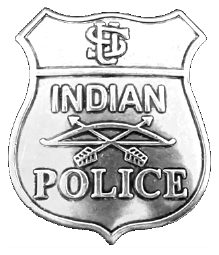United States Indian Police facts for kids
The United States Indian Police (USIP) was a special police force created in 1880. It was started by John Q. Tufts, an Indian Commissioner, in a place called Indian Territory (which is now part of Oklahoma). Their main job was to provide justice and help to Native American tribes recognized by the government. The USIP hired many officers who were already part of tribal police groups called Lighthorsemen. However, unlike the Lighthorsemen who worked for their tribes, the USIP worked under a government official called an Indian agent. Many USIP officers were also given special powers like Deputy U.S. Marshals. This allowed them to work across different areas and even arrest non-Native Americans.
Contents
Training for Indian Police Officers
The United States Indian Police Academy is where USIP officers get their training. It first opened in Roswell, New Mexico, on December 17, 1968. Back then, it was called the United States Indian Police Training and Research Center. The academy offered special training in areas like working with young people in detention, investigating crimes, and supervising others.
In 1973, the academy moved to Brigham City, Utah. It joined with another group that studied law and order. This created the Center for U.S. Indian Police Training and Research. The academy moved again to Marana, Arizona, in 1984. Finally, in 1993, it moved to the Federal Law Enforcement Training Center in Artesia, New Mexico, where it is still located today.
Today, the academy trains officers to meet the needs of justice services in Native American communities. It teaches future USIP officers how to prevent crimes, reduce repeat offenses, and support tribal justice systems. Graduates from the academy become police officers, correctional officers, criminal investigators, tribal court staff, and communication operators.
Who the Indian Police Could Arrest
The USIP gained authority over serious crimes like murder, assault, and arson in Native American communities after the Major Crimes Act was passed in 1885. However, the exact role of the USIP was often unclear. New laws were frequently needed to expand their powers because their duties were not fully planned out at first.
The power of the United States Indian Police to arrest non-Native Americans or those outside their specific area was often questioned. Despite these challenges, laws were passed that gave the USIP power to stop the illegal sale of goods in Indian Territory. This meant they could arrest non-Native Americans who were often involved in smuggling. In 1913, a law called the Appropriation Act gave United States Indian Police the same powers as U.S. Marshals. This helped make their authority stronger.
Police Before the USIP
Before the United States Indian Police was formed, many Native American tribes had their own ways of keeping order. Some tribes believed that keeping order was a job for the whole community. Others had groups similar to police forces.
For example, the Muscogee Creek tribe had a group of respected warriors whose job was to enforce the tribe's laws. The Cherokee tribe had their own police, called the Lighthorse, and a court system. Many tribes did not want the new USIP to replace their existing law enforcement. There was often resistance when the government tried to organize the new police force.
Dealing with Outlaws
One big challenge for the United States Indian Police was dealing with famous outlaw gangs of the Old West. These included groups like the Cooks, the Starrs, and the Daltons. Some outlaws even used their positions to help their illegal activities. For instance, Bob Dalton, a member of the Dalton gang, used his role as Chief of the Osage Police to help his gang smuggle illegal goods.
The Dalton Gang was also known for robberies and other crimes. They often used Indian Territory to hide from officers in Oklahoma. These outlaw groups would often shoot at USIP officers to avoid being caught. Their illegal activities also drew Native Americans into criminal behavior as they bought the smuggled goods. The problem with outlaws became so serious that by 1895, USIP officers were given instructions on how to handle them. They were told to arrest dangerous criminals, and if those criminals fought back, the officers could use force.
Sam Sixkiller: A Brave Officer
Sam Sixkiller was a very important officer. He used to be the High Sheriff of the Cherokee Nation. In 1880, he was chosen to become the Captain of the US Indian Police. He was also a Deputy US Marshal. Sam Sixkiller was known for surviving many gunfights during his six years of service. Sadly, he was shot and killed on Christmas Eve in 1886, when he was unarmed.
After his killers escaped punishment from the Creek and Cherokee courts, the United States Congress passed a new law. This law gave federal courts the power to judge any Native American who committed a crime against a federally appointed Indian police officer or U.S. Deputy Marshal. Sam Sixkiller's death also led to a law that made it a federal crime to kill an Indian police officer. This law is still in effect today.
Other Types of Indian Police
Besides the USIP, there were two other kinds of police officers on Native American reservations:
- Indian tribal police
- Many Native American tribes created their own governments. These tribes hired police officers with different titles, like sheriffs or lighthorsemen. These officers enforced the laws made by their tribes.
- Indian agency police
- Some tribes did not have their own organized governments or tribal laws. In these areas, the Indian agent (a government official) hired Native American police officers from the tribe. These officers kept law and order based on federal rules and treaties. They were considered federally appointed police officers. The Indian police who were involved in the death of Sitting Bull were this type of officer.
Images for kids



